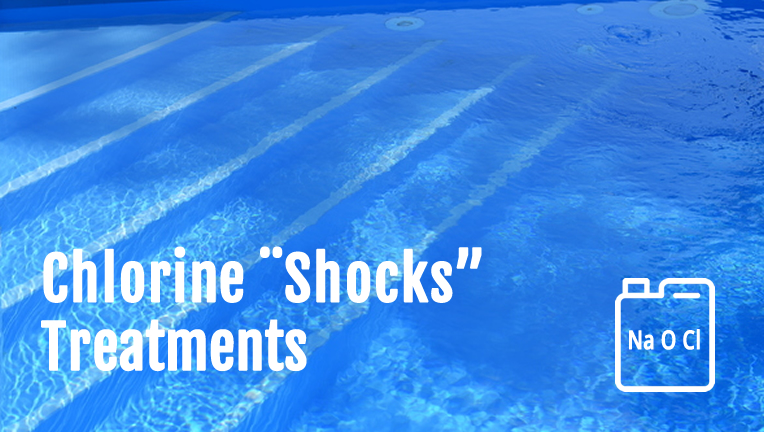Swimming pool waters usually undergo continuous chlorine shock treatment and must maintain a residual chlorine level between 1-3 ppm. Nonetheless, certain environmental conditions or filtration system failures can cause algae blooms. Therefore, when this occurs, shock treatment is necessary.
“Chlorine Shock” treatment
The table below is a guide for shock-type treatments:
How do you estimate how much chlorine to add to a pool?
There are two ways to apply chlorine shock: one is in the pool, and another is through recirculation through a chlorine dispenser.
CALCULATION OF THE VOLUME OF CHLORINE SOLUTION TO ADD (THE SAME POOL):
These are the necessary data:
- Vp = volume of the pool in liters
- DC = dose of chlorine to apply in ppm ≅ mg/L
- C = concentration of sodium hypochlorite % by weight
- ρC = density of the chlorine solution in kg/l
So, we will estimate the volume of sodium hypochlorite VC that we must add to the pool:
- VC = volume of sodium hypochlorite in solution to add to the pool
*1ppm. by weight = 1 kg / ≅ 1 mg / l, since the density of water is approximately equal to 1*
Example
Vp = 300.000 liters
DC = 30 mg/l
C = 12,5 %
ρC = 1.24 kg / l
VC = (0,0001 x 300,000 l * 30 ppm) / (12.5 % * 1.24 kg/l) = 58 L
CALCULATION OF THE VOLUME OF CHLORINE SOLUTION TO ADD IN RECIRCULATION:
First, in the case of recirculation, it is to be pointed out that, as a rule (example: 10 state standards), a pool must recirculate at least its entire volume in six hours, but if it is a pool for children, it is at least two hours.
Also, you must dose the 58 L in a desired period that does not exceed that of the total recirculation of the pool. For example, if the water recirculates its entire volume in 6 hours, you can dose 58 L per 6 hours and must set your dosing pump at 9.6 l/hr.
Would you like more information about which products you need? Click the link and fill out the form!

